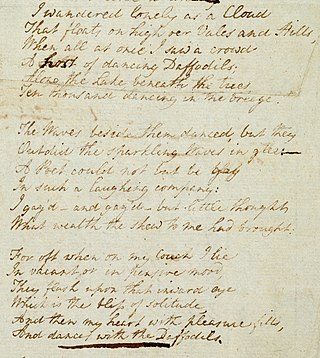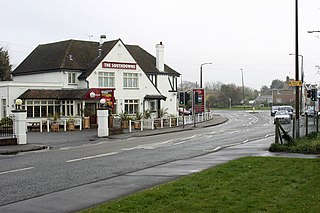
"And did those feet in ancient time" is a poem by William Blake from the preface to his epic Milton: A Poem in Two Books, one of a collection of writings known as the Prophetic Books. The date of 1804 on the title page is probably when the plates were begun, but the poem was printed c. 1808. Today it is best known as the hymn "Jerusalem", with music written by Sir Hubert Parry in 1916. The famous orchestration was written by Sir Edward Elgar. It is not to be confused with another poem, much longer and larger in scope and also by Blake, called Jerusalem The Emanation of the Giant Albion.

William Blake was an English poet, painter, and printmaker. Largely unrecognised during his life, Blake has become a seminal figure in the history of the poetry and visual art of the Romantic Age. What he called his "prophetic works" were said by 20th-century critic Northrop Frye to form "what is in proportion to its merits the least read body of poetry in the English language". While he lived in London his entire life, except for three years spent in Felpham, he produced a diverse and symbolically rich collection of works, which embraced the imagination as "the body of God", or "human existence itself".

William Wordsworth was an English Romantic poet who, with Samuel Taylor Coleridge, helped to launch the Romantic Age in English literature with their joint publication Lyrical Ballads (1798).
This article contains information about the literary events and publications of 1800.

Bognor Regis, also known as Bognor, is a town and seaside resort in West Sussex on the south coast of England, 56 miles (90 km) south-west of London, 24 miles (39 km) west of Brighton, 6 miles (10 km) south-east of Chichester and 16 miles (26 km) east of Portsmouth. Other nearby towns include Littlehampton east-north-east and Selsey to the south-west. The nearby villages of Felpham, and Aldwick are now suburbs of Bognor Regis, along with those of North and South Bersted. The population of the Bognor Regis built-up area, including Felpham and Aldwick, was 63,855 at the 2011 census.

"I Wandered Lonely as a Cloud" is a lyric poem by William Wordsworth. It is one of his most popular, and was inspired by a forest encounter on 15 April 1802 that included himself, his younger sister Dorothy and a "long belt" of daffodils. Written in 1804, this 24 line lyric was first published in 1807 in Poems, in Two Volumes, and revised in 1815.

William Hayley was an English writer, best known as the biographer of his friend William Cowper.
The Landmark Trust is a British building conservation charity, founded in 1965 by Sir John and Lady Smith, that rescues buildings of historic interest or architectural merit and then makes them available for holiday rental. The Trust's headquarters is at Shottesbrooke in Berkshire.

Milton is an epic poem by William Blake, written and illustrated between 1804 and 1810. Its hero is John Milton, who returns from Heaven and unites with the author to explore the relationship between living writers and their predecessors, and to undergo a mystical journey to correct his own spiritual errors.

Felpham is a village and civil parish in the Arun District of West Sussex, England. Although sometimes considered part of the urban area of greater Bognor Regis, it is a village and civil parish in its own right, having an area of 1.645 square miles, (4.26 km),2 with a population of 9,611 people that is still growing. The population at the 2011 Census was 9,746.

Jerusalem: The Emanation of the Giant Albion is a prophetic book by English poet William Blake. Jerusalem is the last, longest and greatest in scope of Blake's works. Etched in handwriting, accompanied by small sketches, marginal figures and huge full-plate illustrations, it has been described as "visionary theatre". The poet himself believed it was his masterpiece and it has been said that "of all Blake's illuminated epics, this is by far the most public and accessible". Nonetheless, only six copies were printed in Blake's lifetime and the book, like all of Blake's prophetic works, was all but ignored by his contemporaries.

Middleton-on-Sea is a village, civil parish and an electoral ward in the Arun District of West Sussex, England, lying to the east of Bognor Regis and neighbouring Felpham. The parish also contains the settlements of Elmer and Ancton. The southern half is urban and the northern rural.

The prophetic books of the 18th-century English poet and artist William Blake are a series of lengthy, interrelated poetic works drawing upon Blake's own personal mythology. They have been described as forming "what is in proportion to its merits the least read body of poetry in the English language". While Blake worked as a commercial illustrator, these books were ones that he produced, with his own engravings, as an extended and largely private project.
Nationality words link to articles with information on the nation's poetry or literature.

Tisman's Common is a hamlet in the Horsham District of West Sussex, England. It stands in the parish of Rudgwick, on the Rudgwick to Loxwood road, 6.4 miles (10.2 km) west of Horsham.

The Firs in Lower Broadheath, Worcestershire, England was the birthplace of Edward Elgar. The cottage now houses a museum administered by the National Trust. Edward Elgar was born at the house on 2 June 1857, and lived there for the first two years of his life. The museum comprises the Birthplace Cottage and its garden, and the modern Elgar Centre, opened in 2000, which houses further exhibitions and a function room.

The Cowper and Newton Museum is a museum in Olney, north Buckinghamshire, England, around 8 miles (13 km) north-east of Central Milton Keynes. Celebrating the work and lives of two famous local residents: William Cowper (1731–1800), a celebrated 18th-century poet; and John Newton (1725–1807), a slave trader and subsequently a prominent abolitionist, who was curate in the local church. Together, Cowper and Newton wrote the Olney Hymns, including one of the world's most popular hymns, "Amazing Grace".

The Notebook of William Blake was used by William Blake as a commonplace book from c. 1787 to 1818.

Hare Street House is a Grade II* listed building in the hamlet of Hare Street that lies between Buntingford and Great Hormead in the East Hertfordshire district of Hertfordshire, England. It is mainly associated with the Roman Catholic priest and writer Robert Hugh Monsignor Benson, who owned the house from 1906 until his death in 1914.

















